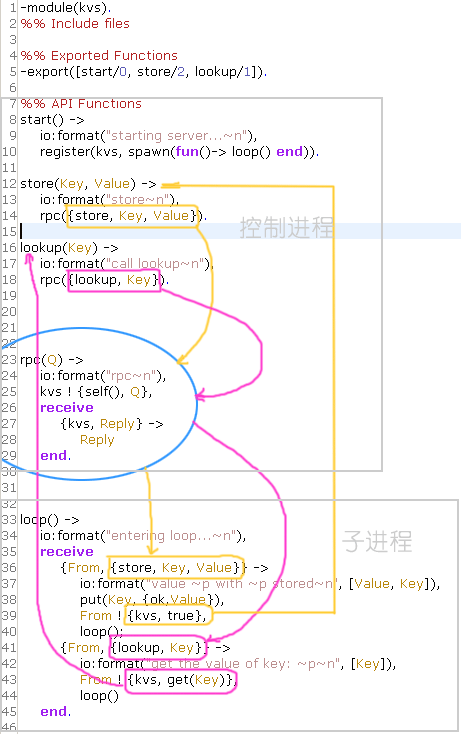Erlang-分布式基础
2011-05-31 创建
2014-09-29 更新
知识点
- 具有相同cookie而且彼此互相连接的节点集称为Erlang 集群
- 设置Cookie的三种方式
$HOME/.erlang.cookieerl -setcookie AFRTY12ESS3412735ASDF12378erlang:set_cookie(node(),C)
Example
1 | -module(kvs). %% Include files %% Exported Functions -export([start/0, store/2, lookup/1]). %% API Functions start() -> io:format("starting server...~n"), % 启动kvs服务,派生一个新进程,进入循环 register(kvs, spawn(fun()-> loop() end)). store(Key, Value) -> io:format("store~n"), rpc({store, Key, Value}). lookup(Key) -> io:format("call lookup~n"), rpc({lookup, Key}). % Local Functions % 消息代理函数 rpc(Q) -> io:format("rpc~n"), % 向进程kvs发送消息 {self(), Q},其中self()表示当前进程Pid, Q为参数 kvs ! {self(), Q}, receive {kvs, Reply} -> Reply end. loop() -> io:format("entering loop...~n"), receive {From, {store, Key, Value}} -> io:format("value ~p with ~p stored~n", [Value, Key]), put(Key, {ok,Value}), From ! {kvs, true}, loop(); {From, {lookup, Key}} -> io:format("get the value of key: ~p~n", [Key]), From ! {kvs, get(Key)}, loop() end |
操作步骤
- 启动两个终端, 分别输入
1 | erl -sname server erl -sname client |
- 在真实的分布式环境中,请使用
1 | erl -name server erl -name client |
-name需要使用到DNS服务,而-sname不需要使用DNS,可用于本机测试,局域网也可以使用-sname启动Erlang系统.
启动服务器, 派生一个新进程,立即进入循环
1 | (server@localhost) > kvs:start(). starting server... entering loop... true |
- 客户端通过RPC调用服务器函数 store 存储一个值
1 | (client@localhost) > rpc:call('server@localhost',kvs,store,[google, "http://www.google.com"]). |
- 服务器输出,再次进入loop等待下一个消息:
1 | (server@localhost) > value "http://www.google.com" with google stored (server@localhost) > loop |
- 客户端查询
1 | (client@localhost) > rpc:call('server@localhost',kvs,lookup,[google]). call lookup rpc {ok,"http://www.google.com"} |
- 服务器输出
1 | (server@localhost) > get the value of key: google (server@localhost) > loop |
- 本地调用实际上也是通过rpc向kvs服务器发送消息
1 | (server@localhost)2> kvs:lookup(google). call lookup rpc get the value of key: google loop {ok,"http://www.google.com"} |
消息传递图示

结语
- 本文使用进程字典作为Key,Value存储仅作为示例,真实环境中是不可能的.切忌照搬.
- 可以把loop()函数中的put和get剥离到两个实现函数中
- 采用什么后端存储就是你的事情了.